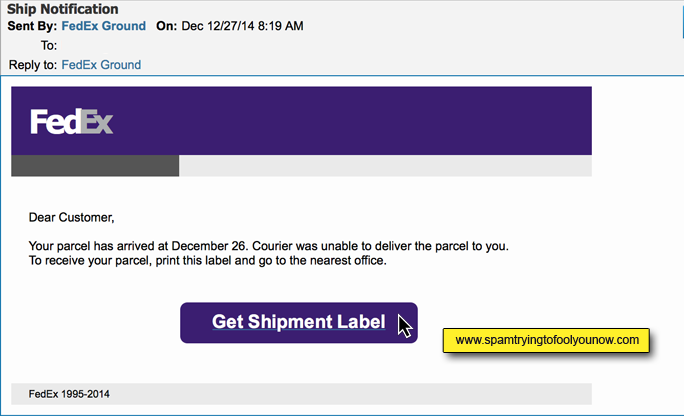Note: Stupid Tip of the Day is a not-so-new regular feature of The Gate which will not be featured regularly — if at all — after today…or maybe not. Does anyone really read these disclaimers, anyway?!?
You have received what appears to be a legitimate e-mail message from a reputable company — such as an airline, for example — but you have no idea as to whether or not it is considered “spam”; and you do not want to click open the e-mail message in case it is loaded with a virus or “malware” of some type.
The example shown above is a screen shot from an actual e-mail message which I received earlier. As a person experienced with graphic design, I know that the FedEx logo is in a typeface similar to Futura Extra Bold; yet the logotype shown above clearly uses a slightly condensed version of Verdana, which is a typeface designed by Matthew Carter for Microsoft Corporation that is usually included with your computer and used extensively throughout the Internet — including as the main typeface for content currently posted on FlyerTalk.
I have isolated the imitation logotype to compare it to the legitimate version, which has a registered trademark symbol — or ® — included…

…but what if you are not a graphic designer — or know little about typefaces and logos?
No need to be concerned, as there is an easy method to discern whether or not the e-mail message is authentic: simply place your cursor over the link where you are instructed to click and leave it there for a brief moment. A “pop-up” alert should show you the actual URL of the link in question — and notice that it does not include “www.fedex.com” in it, as shown in the example at the top of this article.
So that the rogue Internet web site gets no attention, I purposely changed the uniform resource locator — or URL — to something I fabricated.
If for some reason none of the above tips are helpful to you, use a telephone to call the company in question — usually via a toll-free number — and ask whether or not the e-mail message was legitimate. Chances are that the answer is “no”…
…and as I posted in this comprehensive article earlier this month pertaining to how to reduce the risk of credit card fraud and what you can do, the bank which issued one of my credit cards sent an e-mail message on Monday, December 1, 2014 claiming to have denied a charge from a company from which I have never heard. I was asked to click either a green Yes button to verify the legitimacy of that questionable charge; or a red No button to indeed verify that the charge was not legitimate.
I did what you are supposed to do: call the bank which issued the credit card and speak to a live person and never click on the link provided in the e-mail message nor respond to the e-mail message. I have received a lot of e-mail messages lately from what appear to be legitimate companies asking me to click on a link to either send them information or verify something; and almost always, I hover my cursor over the link for a second, which then ultimately reveals an unknown URL that has nothing to do with the legitimate company. This is the usual confirmation that the e-mail message is a “phishing” scam where a questionable entity is attempting to gather vital information from me — most likely for the sender to send a virus to my computer or be able to steal my identity.
Upon calling the telephone number on the rear of my credit card — which I did that evening — the representative confirmed that the e-mail message was not only indeed illegitimate; but there was another questionable charge posted to the account that was not initiated by me.
I wrote this article in the event that you receive what appears to be a legitimate e-mail message from a reputable travel company — whether it is an airline, lodging company, cruise line, parking facility, attraction or rental car company — attempting to prompt you to click on what could actually be a phony link. To reiterate: never click on the link provided in the e-mail message nor respond to the e-mail message, as you could put your computer and your files at risk.
Do you have any additional helpful information to add or experience to impart? If so, please share it in the Comments section below. Thank you.

